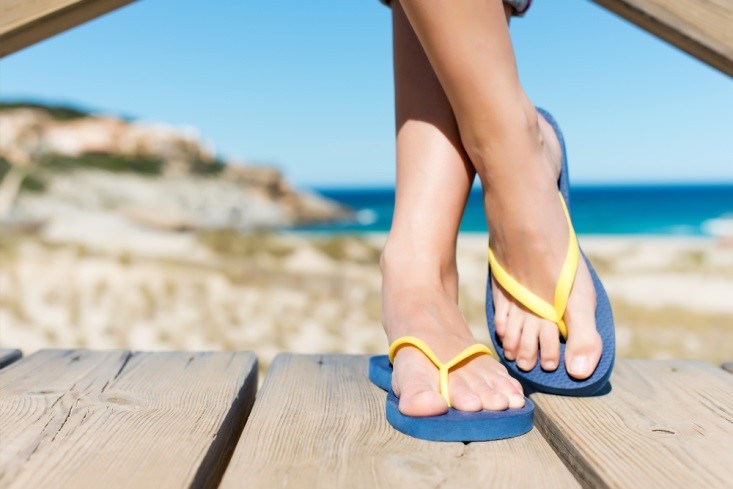By Annette “Dr. Z” Zaharoff, MD
It’s the middle of summer and chances are if you have made a trip to the pool or just put on some shorts and taken a stroll outside, you opted for the convenience of sliding your feet into a pair of flip flops.
It’s a summer thing, I know. In fact, flip flops are no longer just seen at the gym or by the pool. People wear them on everyday treks. Just take a look at people at the mall, or Six Flags or Sea World and chances are good you’ll see a pair of flip flops in most crowds.
The problem is, if you’re wearing the inexpensive, thin, rubber-soled shoes commonly sold at big-box retail stores, then you may be doing damage to your feet that could result in a painful condition known as plantar fasciitis.
Wearing flip-flops regularly can stretch and strain the fascia, a sheet of tissue that connects your heel bone to the base of your toes. This can lead to possibly severe pain in the heel, which is particularly noticeable in the morning when you take your first steps out of bed. The sensation is sometimes likened to needles in the feet.
If plantar fasciitis is left untreated, it may even lead formation of a jagged deposit of calcium commonly referred to as a heel spur. In worst-case scenarios, surgery is required to treat heel spurs.
So what do you do if you develop plantar fasciitis? Usually applying ice, stretching the heel cord and arch, short-term use of a cushioned sole insert and modifying your activities will help resolve the issue.
But recovery will be hampered if you continue to wear flip flops or any shoe with improper support for the arch or heel. Shoes with closed heels, even in the hot summer weather, are better for your feet than flip flops.
So once you’ve switched to more sensible shoes, consider trying these exercises to treat your plantar fasciitis:
- Calf stretching in bed – First thing in the morning when your calf is tight, the muscles can pull on the heel bone, which can tighten the plantar fasciitis condition and make your foot prone to injury. So keep a towel or belt near the bed. Now wrap it around the ball of your feet and keep your leg straight as you gently pull your toes toward you. You will feel the stretch in your calf. Hold it for 20 to 30 seconds. Now relax the stretch. Repeat this method another 3-4 times before getting out of bed.
- Frozen water bottle – You can freeze a plastic water bottle (say 8 to 16 ounces) and roll it under your foot for 10 minutes at the end of the day. The cold will help control the inflammation that may have built up over the day.
- Tennis ball massage – Do the same thing you do with the iced water bottle using a tennis ball. This 10-minute massage will help loosen up the plantar fasciitis, and reduce the likelihood of inflammation. Apply enough pressure to feel a deep massage. Your feet may be a little sore the next day.
None of these exercises is an instant cure for plantar fasciitis. It can take several weeks of therapy for a full recovery. If you don’t realize any significant changes working on your own, you may want to contact a sports medicine physician or a physical therapist to aid you in developing a plan that will be more effective.
And don’t forget to ditch the flip flops!
Dr. Annette “Dr. Z” Zaharoff heads the Non-Surgical Center of Texas, focusing on non-surgical treatments to relieve pain and repair injuries. A former professional tennis player who competed on the WTA circuit, Dr. Zaharoff remains actively involved with the US Tennis Association. Learn more about her at www.drzmd.com. You can follow her on Facebook at www.Facebook.com/DrZaharoff.

